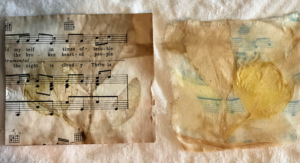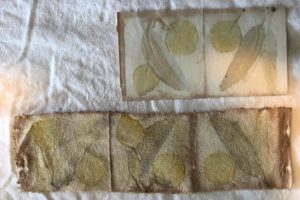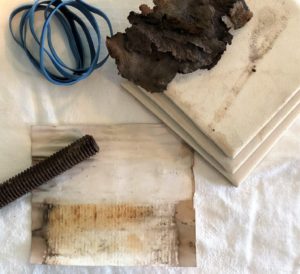Botanical co-Printing on Paper
Janice Johnson, Carson Sierra Weavers Guild
I love eco-printing and I have done most of my eco-printing on silk or cotton, but I wanted to try it on paper. I couldn’t wait for Mother Nature, so the only leaves I had to experiment with were sagebrush and rabbit brush; everything else was still dormant in Nevada’s high desert. I also had some dried eucalyptus leaves that I’d collected in California, years ago. I have on hand an iron water solution I make by putting bits of rusty metal in a big jar of water. As I use it, I just add more water. It seems to last indefinitely. I made a dye bath of yellow onion skins.
To make the paper samples I cut 4-1/2”X4-1/2” pieces of watercolor paper, sketch paper, old music and expired aeronautical charts. I set a 4” square ceramic tile, face up on the table, then a piece of paper, spritzed with vinegar water, then leaves either face up or down or bits of rusty metal. In the samples shown here I then placed a piece of silk over the leaves that had been dipped and wrung out in the iron water. If you want to omit the silk, you can just dip the leaves in the iron water. You do not want to omit the iron water as it is an important part of the chemical process. I continued adding layers of paper, leaves and silk until my bundle was about 2” thick. I placed a second tile, shiny side down and tightly rubber banded the bundle. When all of my bundles were complete, I simmered them in the onion dye bath for about 3 hours.
Most deciduous leaves are worth trying. Most Eco-printers love eucalyptus, but don’t despair if these aren’t in your area. Some of my favorite leaves are ornamental purple leaves and plain old rose leaves. The top of the leaf will print differently than the bottom. Some leaves that don’t print will act as a relief. Leaves will also print differently in spring than in the fall. Don’t forget to try some flat flowers. If you have flowers that aren’t flat enough, you can always just add a few petals. Bits of rusty metal are also fun to add. As you can see the possibilities are endless.
Remove the bundles from the dye bath and let cool. When they are cool enough to handle take the bundle apart and let the paper dry. To flatten it I ironed it between two paper towels. You can use these samples as ideas for future eco-printing projects or to decorate gift cards or tags. Hopefully they’ll inspire you try more eco-printing.
Supplies
Watercolor paper & sketch paper, old music & aeronautical charts
Habotai & raw silk, but any fabric would do
4” square ceramic tiles
Heavy rubber bands
Iron water, made by soaking rusty bits in water
Spray bottle with a solution of 50% white vinegar and water
Leaves- Eucalyptus, sagebrush and rabbitbrush
Pot with dye bath of yellow onion
Clockwise: rubber bands, rusty metal, ceramic tiles, re-bar, Janice Johnson


